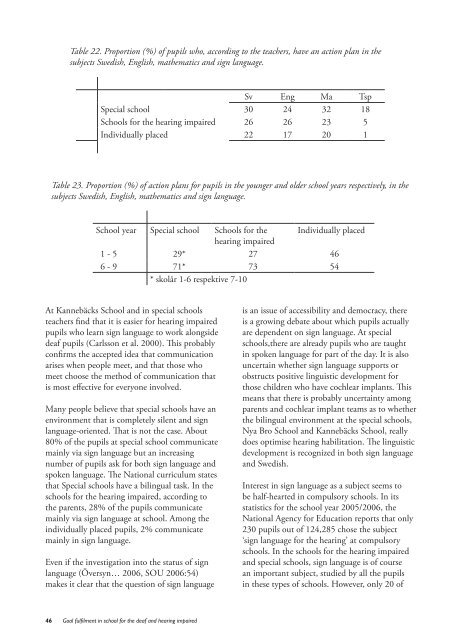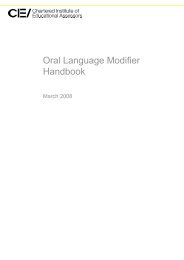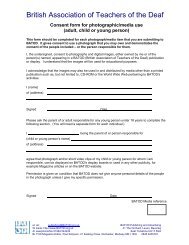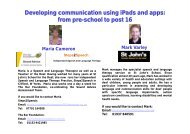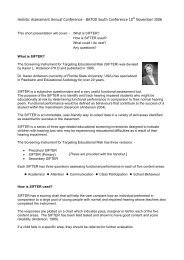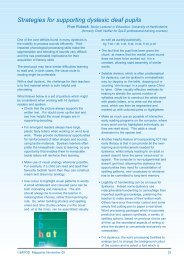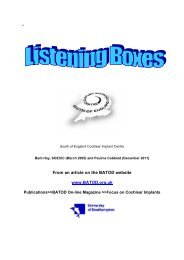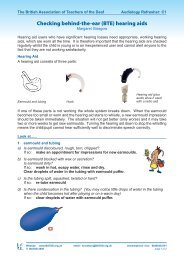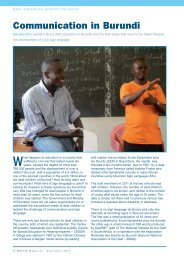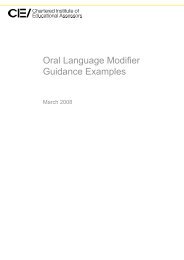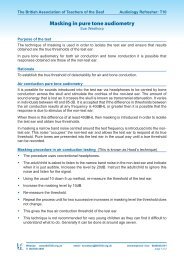Goal fulfilment in school for the deaf and hearing impaired - batod
Goal fulfilment in school for the deaf and hearing impaired - batod
Goal fulfilment in school for the deaf and hearing impaired - batod
- No tags were found...
Create successful ePaper yourself
Turn your PDF publications into a flip-book with our unique Google optimized e-Paper software.
Table 22. Proportion (%) of pupils who, accord<strong>in</strong>g to <strong>the</strong> teachers, have an action plan <strong>in</strong> <strong>the</strong>subjects Swedish, English, ma<strong>the</strong>matics <strong>and</strong> sign language.Sv Eng Ma TspSpecial <strong>school</strong> 30 24 32 18Schools <strong>for</strong> <strong>the</strong> hear<strong>in</strong>g <strong>impaired</strong> 26 26 23 5Individually placed 22 17 20 1Table 23. Proportion (%) of action plans <strong>for</strong> pupils <strong>in</strong> <strong>the</strong> younger <strong>and</strong> older <strong>school</strong> years respectively, <strong>in</strong> <strong>the</strong>subjects Swedish, English, ma<strong>the</strong>matics <strong>and</strong> sign language.School year Special <strong>school</strong> Schools <strong>for</strong> <strong>the</strong> Individually placedhear<strong>in</strong>g <strong>impaired</strong>1 - 5 29* 27 466 - 9 71* 73 54* skolår 1-6 respektive 7-10At Kannebäcks School <strong>and</strong> <strong>in</strong> special <strong>school</strong>steachers f<strong>in</strong>d that it is easier <strong>for</strong> hear<strong>in</strong>g <strong>impaired</strong>pupils who learn sign language to work alongside<strong>deaf</strong> pupils (Carlsson et al. 2000). This probablyconfirms <strong>the</strong> accepted idea that communicationarises when people meet, <strong>and</strong> that those whomeet choose <strong>the</strong> method of communication thatis most effective <strong>for</strong> everyone <strong>in</strong>volved.Many people believe that special <strong>school</strong>s have anenvironment that is completely silent <strong>and</strong> signlanguage-oriented. That is not <strong>the</strong> case. About80% of <strong>the</strong> pupils at special <strong>school</strong> communicatema<strong>in</strong>ly via sign language but an <strong>in</strong>creas<strong>in</strong>gnumber of pupils ask <strong>for</strong> both sign language <strong>and</strong>spoken language. The National curriculum statesthat Special <strong>school</strong>s have a bil<strong>in</strong>gual task. In <strong>the</strong><strong>school</strong>s <strong>for</strong> <strong>the</strong> hear<strong>in</strong>g <strong>impaired</strong>, accord<strong>in</strong>g to<strong>the</strong> parents, 28% of <strong>the</strong> pupils communicatema<strong>in</strong>ly via sign language at <strong>school</strong>. Among <strong>the</strong><strong>in</strong>dividually placed pupils, 2% communicatema<strong>in</strong>ly <strong>in</strong> sign language.Even if <strong>the</strong> <strong>in</strong>vestigation <strong>in</strong>to <strong>the</strong> status of signlanguage (Översyn… 2006, SOU 2006:54)makes it clear that <strong>the</strong> question of sign languageis an issue of accessibility <strong>and</strong> democracy, <strong>the</strong>reis a grow<strong>in</strong>g debate about which pupils actuallyare dependent on sign language. At special<strong>school</strong>s,<strong>the</strong>re are already pupils who are taught<strong>in</strong> spoken language <strong>for</strong> part of <strong>the</strong> day. It is alsouncerta<strong>in</strong> whe<strong>the</strong>r sign language supports orobstructs positive l<strong>in</strong>guistic development <strong>for</strong>those children who have cochlear implants. Thismeans that <strong>the</strong>re is probably uncerta<strong>in</strong>ty amongparents <strong>and</strong> cochlear implant teams as to whe<strong>the</strong>r<strong>the</strong> bil<strong>in</strong>gual environment at <strong>the</strong> special <strong>school</strong>s,Nya Bro School <strong>and</strong> Kannebäcks School, reallydoes optimise hear<strong>in</strong>g habilitation. The l<strong>in</strong>guisticdevelopment is recognized <strong>in</strong> both sign language<strong>and</strong> Swedish.Interest <strong>in</strong> sign language as a subject seems tobe half-hearted <strong>in</strong> compulsory <strong>school</strong>s. In itsstatistics <strong>for</strong> <strong>the</strong> <strong>school</strong> year 2005/2006, <strong>the</strong>National Agency <strong>for</strong> Education reports that only230 pupils out of 124,285 chose <strong>the</strong> subject‘sign language <strong>for</strong> <strong>the</strong> hear<strong>in</strong>g’ at compulsory<strong>school</strong>s. In <strong>the</strong> <strong>school</strong>s <strong>for</strong> <strong>the</strong> hear<strong>in</strong>g <strong>impaired</strong><strong>and</strong> special <strong>school</strong>s, sign language is of coursean important subject, studied by all <strong>the</strong> pupils<strong>in</strong> <strong>the</strong>se types of <strong>school</strong>s. However, only 20 of46 <strong>Goal</strong> <strong>fulfilment</strong> <strong>in</strong> <strong>school</strong> <strong>for</strong> <strong>the</strong> <strong>deaf</strong> <strong>and</strong> hear<strong>in</strong>g <strong>impaired</strong>


